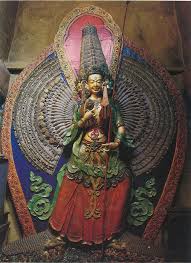Tutelary Deity Sitatapatra
Sitatapatra, Vajra Ushnisha (Tibetan: do rje tsug tor dug kar mo, English: The White Parasol One of the Vajra Crown Protuberance [of the Buddha]).
White in colour with 1000 faces, 1000 hands, 1000 legs and 10,100,000 (ten million one hundred thousand) eyes, the main face in front is white, showing a fierce expression, with a wide gaping mouth and a further 199 white faces above. To the left is a vertical row of yellow faces, to the right is a vertical row of green faces. On both sides are red faces and on top appearing as a cap are 200 blue faces. Each face has three eyes and glares with a fierce expression. In the first pair of hands the right, extended downward, holds a Dharma Wheel and the left holds an arrow together with the gold handle of a parasol, held to the heart, unfurled above on the right side. She is adorned with various jewel ornaments, a necklace of fifty freshly severed heads each in a different colour and expression and a long snake necklace. As a lower garment she wears a fresh tiger skin skirt fastened with a belt of green silk.
A further 99 pairs of hands hold in the right a Dharma Wheel and an arrow in the left. The remaining 400 hands on the right hold a vajra, jewel, visvavajra (double vajra) and lotus, 100 of each object. The remaining 400 hands on the left hold a bow, flame tipped sword, lasso and hook, again 100 of each object. The first ten hands clearly display the objects as examples while the remaining 990 grow increasingly smaller with each outward concentric circle. Again, in the palm of each hand is a staring eye.
The 500 legs on the left side are extended above worldly deities and a host of animals and the legs on the right are bent and press down on all worldly troubles, daemons and animals. Standing above a sun disc and multi-coloured lotus seat she is completely surrounded by the flames of pristine awareness, richly stylized and containing numerous wish-fulfilling jewels.
At the top center is a smiling lama, seated, wearing monastic robes and a yellow cap with red trim. With the right hand he holds the stem of a pink lotus to the heart which blossoms at the right ear and supports a vajra and bell. The left hand holds a long-life vase in the lap, richly attired in silk brocades. At both sides are five seated buddhas wearing monastic robes and performing various mudras.
At the bottom center is the peaceful long-life goddess Ushnishavijaya, white, with three faces and eight hands seated in vajra posture. She also was born from the ushnisha (crown protuberance) of the Buddha. On the left side, level with the lotus of the central figure, is the black wrathful deity Mahakala with one face and two hands holding a stick and skullcup, wearing long garments; standing on a corpse and lotus seat. The remaining 35 peaceful goddesses, in various colours, each have one face and two hands and hold a variety of objects and perform numerous mudras, seated on moon discs and lotus cushions. The 10 buddhas, Mahakala and the 35 goddesses form the mandala retinue of Sitatapatra.
The practice of Sitatapatra is common to both Nyingma and Sarma Traditions. According to the Sarma Schools she belongs to the Kriya Classification of Tantra.
Sarma Lineage: Buddha Tathagata, Ushnisha Sitatapatra, Vajrapani, Dasa Samadhi, Candragomin, Giravati, Vajra Tikshna, Padma Angkusha, Brahmin Ratna Vajra, Jetari, Vajrasana the Senior and Younger, Bari Lotsawa, Denma Kyura Akyab, Sachen Kunga Nyingpo (1092-1158), etc.
J.Watt 6-98
